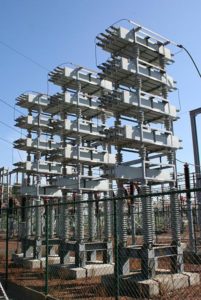Power Correction
Our electrical power system, the grid, runs on Alternating Current (AC). It was conceived, designed, and built in the late 1880’s, by Nikola Tesla working with George Westinghouse. More accurately, it is the Poly-Phase Alternating Current system. At the heart of the system is the rotating field electric generator and motor. Early systems were two phase, three wire systems, with each phase 90 degrees apart, and a common (neutral) return wire. These were quickly replaced with three phase, three wire systems, with each wire carrying a phase 120 degrees from the other wires. Since the same number of wires actually carry more electric power in the three phase system, and the power has a smoother quality for operating large motors and generators, the three phase system became the standard worldwide.

Poly-Phase
Condensor
Motors
Save Money
Electrical Systems
Poly-phase electrical systems were primarily invented by Nikola Tesla, Galileo Ferraris, and Mikhail Osipovich Dolivo-Dobrovolsky.
Tesla designed electrical power systems for large motors and generators. The system could generate power hundreds of miles away from the users, and with another Tesla invention, the poly-phase transformer, deliver the electric power with only a modest power loss en route. As a side benefit, electric incandescent lamps (Edison bulbs) work perfectly with AC electrical systems.
The inventors of the electrical power system realized there was a missing component for the efficient operation of the system. There was a need to match the generators to the motors electrical use. This component is the “condenser” or capacitor. Electric motors had a “lag” in the current because it takes time to magnetize the iron core of the motor for each cycle the AC. The capacitor has exactly the opposite behavior as they easily absorb the leading current. Thus adding capacitors compensates for the motor lag current.
Measurement of the “lead” or “lag” current were designed, and capacitors were added to the electrical power system to balance the motors. Since capacitors are expensive and only needed to balance out the use of motors, metering was invented to charge industrial electric users for the “power factor” caused by industrial motors. In response, industrial electric users installed their own capacitor systems to balance the power factor and reduce the electric charges. These capacitor systems were expensive, but cost less than the electric charges they saved.
Over time, more electric motors were used by light commercial and residential electric users. The electrical power system added capacitors to generally balance the power factor. The metering required to measure power factor at every user was too expensive, so electric rates were increased to pay for the capacitors on the electric grid.
Now there are a wide selection of power factor correction systems. Most are quite expensive. The EnergyMizer is a low cost power factor corrector. It has at least one large capacitor. The manufacturer claims there is some automatic circuitry to adjust the capacitor, but I have not been able to verify that claim.
The EnergyMizer power factor correction will reduce the electric use of electric motors used on the same sub panel just as the industrial systems. The motor runs better because the current “lag” is compensated by the EnergyMizer capacitor “lead”. The current stays local to the sub panel instead of going through the power meter and grid wiring. The motor runs more efficiently, so it uses less power, which provides a second amount of electric savings. If the motors are indoors, like refrigerators, more power is saved because the motor runs cooler, which requires less air conditioning power.
For air conditioners there are more savings. In addition to the savings above, the air conditioning compressor is cooled by the freon, so more efficient motor operation means less heat into the freon, so the freon is colder. Colder freon drops the evaporator coil temperature which dehumidifies better. The colder air cools faster, so the air conditioner cycle is shorter.
References:
Please read this first reference article. It clearly explains what Power Factor is, and that customers can supply their own power factor correction equipment, with an example of an automatic power factor correction unit.
References:
Please read this first reference article. It clearly explains what Power Factor is, and that customers can supply their own power factor correction equipment, with an example of an automatic power factor correction unit.
Wikipedia article on Power Factor
In an electric power system, a load with a low power factor draws more current than a load with a high power factor for the same amount of useful power transferred. The higher currents increase the energy lost in the distribution system, and require larger wires and other equipment. Because of the costs of larger equipment and wasted energy, electrical utilities will usually charge a higher cost to industrial or commercial customers where there is a low power factor.
Linear loads with low power factor (such as induction motors) can be corrected with a passive network of capacitors or inductors. Non-linear loads, such as rectifiers, distort the current drawn from the system. In such cases, active or passive power factor correction may be used to counteract the distortion and raise the power factor. The devices for correction of the power factor may be at a central substation, spread out over a distribution system, or built into power-consuming equipment.
A high-voltage capacitor bank used for power factor correction on a power transmission system.
In electric power distribution, capacitors are used for power factor correction. Such capacitors often come as three capacitors connected as a three phase load. Usually, the values of these capacitors are given not in farads but rather as a reactive power in volt-amperes reactive (var). The purpose is to counteract inductive loading from devices like electric motors and transmission lines to make the load appear to be mostly resistive. Individual motor or lamp loads may have capacitors for power factor correction, or larger sets of capacitors (usually with automatic switching devices) may be installed at a load center within a building or in a large utility substation.

A high-voltage capacitor bank used for power factor correction on a power transmission system.
Reference Articles
Example Industrial power factor correction equipment, also look at ABB website if interested.
http://www.galco.com/circuit/PFCC_har.htm
Another power factor correction company
http://www.powerfactorservices.ca/
http://en.wikipedia.org/wiki/Static_VAR_compensator
http://en.wikipedia.org/wiki/Synchronous_condenser
Tesla poly-phase motor patent
http://www.google.com/patents/US381968
For reference you will see power factor correction is a common topic in “The Electric Journal 1908”
Three phase electric power on Wikipedia
http://en.wikipedia.org/wiki/Three-phase_electric_power
Power factor on Wikipedia
http://en.wikipedia.org/wiki/Induction_motor#Power_factor
Energy-Efficient Electric Motors and Their Applications
The book also includes a big chapter on power factor correction
EMI / RFI Reduction
ElectroMagnetic Interference and Radio Frequency Interference are both reduced by the Energymizer, which has high quality, high frequency capacitors to absorb the interference. When the various interference is reduced, the power line has cleaner power to deliver. All electrical equipment runs better, more efficiently, with clean line power.
There are many studies which show health and wellness improvements with reduced electrical interference. People, and all biological organisms, are sensitive to electrical and magnetic changes, generally in a negative way.
In many ways, Edison was right when he installed the first electrical systems with Direct Current. Direct current was not very practical for electric use on the massive scale which we have today. I could go on with a long analysis of the benefits and weaknesses of the two systems, AC and DC, but it would become a very long paper. We can save that for another day.
Surge Protection
Two types of surges are addressed:
Line Surges
These are caused by other users on the power grid connecting and disconnecting loads. When there are sudden load changes on the power grid, it takes the grid some time to adjust to the new load.
Line Droop
It is obvious that the supply voltage momentarily drops when a large load is connected to the grid. The load demands a lot of power to get started, which pulls down the supply voltage momentarily. In a few seconds the grid responds and the voltage is returned to normal.
Line Spike
It is not so obvious that the supply voltage momentarily spikes up when a large load is disconnected from the grid. When the load is suddenly reduced, the power keeps surging in like a wave hitting a cliff. The supply voltage momentarily spikes. In a few seconds the grid responds and the voltage is returned to normal.
The same thing happens in the water supply system. When a large load is suddenly turned on, say a dishwasher or washing machine starts filling, the water pressure drops for a short time. The pressure returns close to normal in a few seconds. When the dishwasher stops filling, the line pressure suddenly increases for a short time.
The EnergyMizer helps a small amount for line surges, since it has energy storage capacitors. The energy storage in each capacitor is quite small compared to the load demand change, so each EnergyMizer only helps a small amount. The more EnergyMizers that are in use, the more they will collectively even out these load changes, thus the better the power line quality.
Efficient. Power Saving. Money Saving
Discover the value that the EnergyMizer will bring to your home.
ORDER NOW to begin saving Energy & Money
